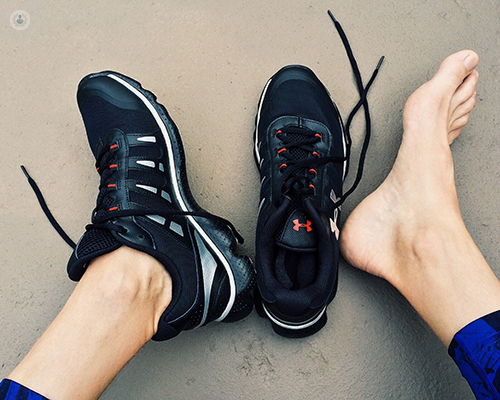Osteoarthritis in the feet: what does it feel like?
Escrito por:Osteoarthritis, the most commonly suffered form of arthritis that affects millions worldwide, occurs due to the gradual wearing down over time of the cartilage that protects the ends of the bones. In our latest article, highly esteemed and accomplished consultant orthopaedic surgeon, Mr Bal Dhinsa, tells us all there is know with regards to osteoarthritis in the feet, including what it feels like, what the main symptoms are, as well as how it is typically treated.

What is osteoarthritis and what are the symptoms in the foot?
The bones on either side of the joints in the foot are lined with cartilage. If this lining becomes damaged, it can lead to arthritis.
Degenerative changes in the joints of the foot are rarely primary arthritis and usually result from trauma to the area (fractures, dislocations or sprains), from other deformities (such as flat feet) or from inflammatory causes (such as rheumatoid disease).
Patients typically experience pain on the top of the foot, which can be worse in the morning and progresses with prolonged weight-bearing. There is associated swelling, and, with time, more obvious deformities in the foot can develop.
What are the four different stages of osteoarthritis?
There are generally four stages used to describe osteoarthritis. Stage one is described as minor wear and tear changes seen associated with minimal pain. This may progress to having more noticeable bone spurs around the affected joint and more discomfort (stage two) and then cartilage erosion (stage three). The final stage typically has very little cartilage present in the joint surfaces (termed bone-on bone) with deformity and pain associated.
What does osteoarthritis in the feet feel like?
In can vary from intermittent pain and swelling to significant pain and restricted movement of the joints involved. The reason for seeking medical attention is often deformity associated with osteoarthritis, which can affect weight-bearing and function.
How is osteoarthritis treated in feet?
This will depend on the stage of the osteoarthritis. Initial pain relief can be achieved with analgesics, non-steroidal anti-inflammatory medications, modification of footwear and activities, as well as orthotics to off-load the painful area. Depending on the patient, weight loss may help reduce the pressure in this area, as well as physiotherapy to keep the joints supple and surrounding muscles strong.
If these measures fail to resolve the symptoms, a corticosteroid injection into the joint may be of benefit to help control pain and allow activities to continue. If the arthritis is mild-to-moderate, with the pain resulting from the pressure effect of bone spurs present, then it is reasonable to remove these to help with the symptoms.
However, if there is rigidity of movements and the arthritis is more advanced, the operative option is to fuse the joints affected to alleviate the pain. For the forefoot, there are other surgical options such as joint replacements, but this tends to be reserved for patients who are not very active due to the potential complications from excessive wear of the prosthesis.
What exercises can be done to help osteoarthritis in feet?
People who exercise regularly typically do not experience as much pain, will have more energy and better function. It is important to try to keep the joints supple. Activities such as yoga and pilates are very good for the whole body.
For the foot, simple stretching and a range of motion exercises are key. It is important to start slow, move gently, stop if your foot starts to hurt (listen to your body) and take appropriate rest.

Can osteoarthritis in feet be prevented? If so, how? If not, why?
Osteoarthritis, unfortunately, cannot be prevented and no cure is known. However, early recognition and taking steps to prevent progression of the pain and deformity can help greatly. Factors that can help include maintaining a healthy weight, avoiding injury, taking precautions at work and wearing proper-fitting shoes that fit the shape of your foot.
Mr Bal Dhinsa is an exceptionally well-regarded and highly experienced consultant orthopaedic surgeon who specialises primarily in conditions that affect the foot and ankle. Check out his Top Doctors profile to book an appointment with him.


